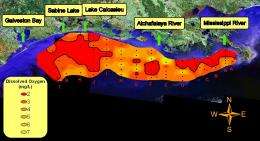Scientists find changes to Gulf of Mexico dead zone

NOAA-supported scientists have found this year's Gulf of Mexico dead zone to be the fifth largest on record at 7,722 square miles - an area the size of New Jersey, near the upper limit of their projections, but tropical storm activity in the Gulf of Mexico caused the zone to be a patchwork rather than a continuous band.
This year’s dead zone is nearly double that of 2009’s, which was smaller than average. A series of storms and high wind and wave conditions in the shallower waters to the west of the Atchafalaya River delta mixed oxygen into the traditional dead zone area before last year’s survey cruise. Last year’s dead zone measured approximately 3,000 square miles.
The research cruise, led by Nancy Rabalais, Ph.D., director of the Louisiana Universities Marine Consortium, conducted a survey that extended from the Mississippi River delta west to Galveston Bay. In the western portion of the dead zone scientists found the largest area of low oxygen off the upperTexas coast since surveys began in 1985. The eastern portion of the dead zone does overlap with the region significantly impacted by the Deep Water Horizon oil spill, however, scientists conducting the cruise think that it is unlikely that the oil spill had a significant impact on the size of the zone.
“Large algal blooms seen in surface waters to the west of the river were not unusual considering the prediction of size for 2010 and the continued input of fresh water and nutrients from the river,” said Rabalais. “It may be difficult to link conditions seen this summer with oil from the BP spill.”
The dead, or hypoxic, zone is fueled by nutrient runoff from agricultural and other human activities in the Mississippi River watershed, which stimulates an overgrowth of algae that sinks, decomposes and consumes most of the life-giving oxygen supply in bottom waters. The Gulf of Mexico dead zone is of particular concern because it threatens valuable commercial and recreational Gulf fisheries that generate about $2.8 billion annually.
The average size of the dead zone over the past five years has been 6,653 square miles, much larger than 1,900 square miles which is the target goal set by the Gulf of Mexico/Mississippi River Watershed Nutrient Task Force. Last year’s dead zone measured approximately 3,000 square miles.
“Despite fluctuations in the size of the dead zone due to short-term weather events, the fact remains that we have a large and persistent area of severely degraded habitat that is caused by excessive nutrient pollution draining into the Gulf,” said Robert Magnien, Ph.D., director of NOAA’s Center for Sponsored Coastal Ocean Research. “Additional threats to the Gulf’s economically important living resources, such as the recent oil spill, only increase the urgency to implement nutrient reduction efforts that will help to restore critically needed habitat.”
The models used to forecast the area of the dead zone allow scientists to understand the area’s important underlying causes, so they can give accurate data for long-term management decisions. The models do not currently look at short-term variability due to weather patterns, or the potential effects of the oil spill. This summer’s dead zone may have been even larger, but Rabalais was unable to fully document the western extent of zone due to time constraints.
Earlier this summer, NOAA-sponsored forecast models developed by R. Eugene Turner, Ph.D., Louisiana State University and Donald Scavia, Ph.D., University of Michigan, predicted that the hypoxic zone would be larger than average. Despite the presence of tropical storms, which cause water mixing and can temporarily provide oxygen to bottom waters, continued high discharge from the Mississippi River set conditions for a large dead zone, as predicted.
Provided by NOAA













